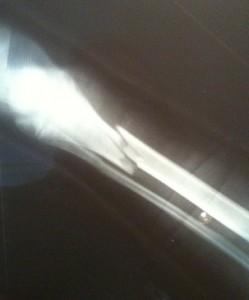
Clean break. Needed a plate for permanent repair and "retained hardware" as a pre-existing condition.
Yep, it’s broke. Snapped! The fracture was the result of the impact between a bike and my son’s leg. Of course, 12 year olds are resilient. Put a cast on the leg and he’ll be back jogging in no time. This broken leg didn’t want to heal. After 2 weeks of trying to get the bones to line up and mend, with no luck, it was time for the serious measures: surgery.
At the end of the surgery, because pins were not successful, my son now has a plate in his leg. While there is not enough metal between the plate and screws to set off the airport metal detector, he will be branded forever as having “Retained Hardware”. As crazy as it sounds, having retained hardware is a pre-exisiting condition to a health insurance company. For this pre-existing plate he will automatically have a rate increase of at least 10% over standard rates on an individual plan for life. (This will not be the case if the ACA is implemented in 2014)
Many conditions have rate increases
While there are many conditions that will get you denied health insurance, there are a large number that will result in rate increases. Health insurance companies look at your age and the severity of the condition, medications and treatment when determining if they will issue you a health insurance policy at anywhere from 10% to 100% above standard rates. There are many pre-existing chronic conditions where the rate increase will actually decrease with age. Sometimes you are rewarded for managing chronic illness for many years and other times the illness will cause fewer medical issues as you get older.
Most rate increases soften with your age
A good example of this is Abnormal PAP. For younger women that have received abnormal PAP, considered low grade, the rate increase from some health insurers can be 90% or decline. The same test for women age 40 – 49 would result in a 30% rate increase. Arthritis, non-rheumatoid, diagnosed in a younger person, up to age 30, may see a rate increase of 10%. After 40, with the same arthritis, no medications, there may not be a rate up at all. If a hearing aid has been recommended to a person under 30, it is a virtual decline. However, once you hit 50 (I’m almost there) needing a hearing aid (but not having one like me) is only a 20% rate increase.
It never hurts to call
The lesson is that if you were subject to a rate increase when you were younger because of a pre-existing condition, and nothing as changed, call your insurance company to see if you can get a rate decrease because of your age. They will want to see that you have managed and maintained your condition. They may ask you get to some lab tests or a note from your doctor. But that is of little expense if you can save yourself 10% – 20% on your health insurance premiums.